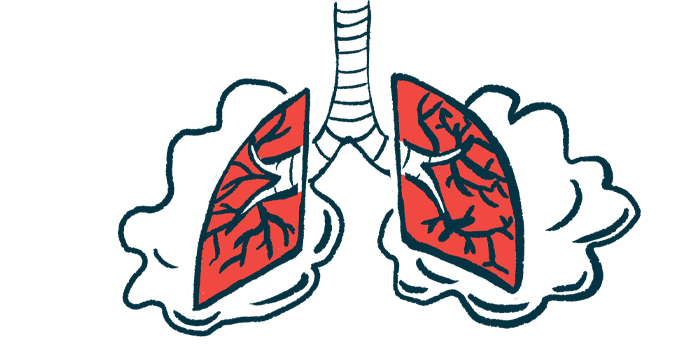Patterns in HRCT Lung Scans May Predict Survival Rates in IPAH

The presence of specific patterns called centrilobular ground-glass opacifications (cGGOs) in high-resolution computed tomography (HRCT) lung scans is associated with a two-year higher risk of death in people with idiopathic pulmonary arterial hypertension (IPAH), according to a small study in Poland.
These findings suggest that chest HRCT data could serve as a complementary prognostic marker and that IPAH patients with cGGOs should be considered for early referral to lung transplant centers, the researchers noted.
Larger studies are needed to confirm these findings.
The study, “Predictive value of chest HRCT for survival in idiopathic pulmonary arterial hypertension,” was published in the journal Respiratory Research.
Lung transplant is the ultimate cure for advanced IPAH, a form of pulmonary arterial hypertension with no known cause. Referral timing for lung transplant “should be based on a patient’s individual survival prognosis and expected waiting time on local transplant list,” the researchers wrote.
Currently, few risk stratification tools are recommended for prognosis assessment, and they don’t incorporate findings of chest HRCT, despite some previous studies linking the presence of cGGOs on the lung scans with increased risk of death in IPAH patients.
Ground glass opacity (GGO) refers to the hazy, white-flecked pattern that can show up in CT scans of the lungs, which normally appear black in the scans. GGOs indicate increased density, meaning that something — either fluid, cells, or abnormally thick walls — is partly filling the air spaces inside the lungs.
GGOs can be classified as centrilobular when they are at the center of the lung’s functional units, the secondary lung lobules, and as panlobular (pGGO) when more widespread.
Now, a team of researchers in Poland assessed the frequency and clinical significance of GGO in 110 adults with IPAH (80 women and 30 men), who were diagnosed at their hospital between 1997 and 2011.
The team retrospectively analyzed the patients’ demographic, HRCT, and clinical data to ultimately verify if GGO carried an additional prognostic value in reference to current risk stratification tools.
Patients had a median age of 44.3 (range 17.3–78.5) and were followed up for a median of five years (range from about 1 month to 22 years).
Results showed that GGOs were detected in 50 (46%) patients, pGGOs in 26 of them (24%), and cGGOs in 24 (22%). These abnormal patterns were significantly more frequent among women, younger patients, patients with better exercise capacity, and those with a history of coughing blood.
Further analysis revealed that a history of coughing blood, higher number of low-risk factors, and lower cardiac output were independent predictors of pGGOs. Patients with a history of coughing blood, younger age, higher right atrial pressure, or higher mixed venous blood oxygen saturation were more likely to have GGOs.
Right atrial pressure represents the blood pressure in the upper-right chamber of the heart, while mixed venous blood oxygen saturation reflects the amount of oxygen “left over” after the tissues remove what they need.
In addition, cGGO, but not panlobular GGO, showed prognostic value in the following two years, being associated with a six times higher risk of negative outcome.
The cGGO group had the shortest median lung transplant-free survival (3.4 years), compared with both the pGGO group (6.2 years) and the group of patients without GGO, or the non-CGO group (5.8 years).
A significantly greater proportion of patients with cGGO died in the first, second, and third year post-HRCT (33–42%), relative to the other two groups (11–16% in the pGGO group and 0–25% in the non-GGO group).
Survival rates at one, two, and three years in the cGGO group “were similar to those reported for high-risk group PAH patients in national and international registries, although only 17% of cGGO patients were in the high-risk group at the [initial] assessment,” based on prognostic factors commonly used for risk stratification, the researchers wrote.
The predictive value of cGGO was not observed over longer term, which may be due to “the high mortality in the cGGO group in the first years of follow-up, and small number of these patients staying in observation for longer than 6 years,” they added.
These findings highlight that GGOs are “frequent findings on the lung HRCT scans of IPAH patients,” the team wrote.
The presence of cGGOs “has an add-on prognostic value for an outcome in a 2-year follow-up in reference to already well-established prognostic factors …, and could serve as a complementary element in making therapeutic decisions,” the researchers added.
In IPAH patients showing cGGO on their lung HRCT scans, an early referral to lung transplant centers should be considered, they said.
“With such approach, evaluation of the disease dynamic and response to medical treatment on one hand, and necessary LTx [lung transplant]-related assessment on the other hand, could be done in parallel, improving timing for LTx listing,” they concluded.
Larger prospective studies are needed to confirm these findings and the predictive value of cGGOs in this patient population.








